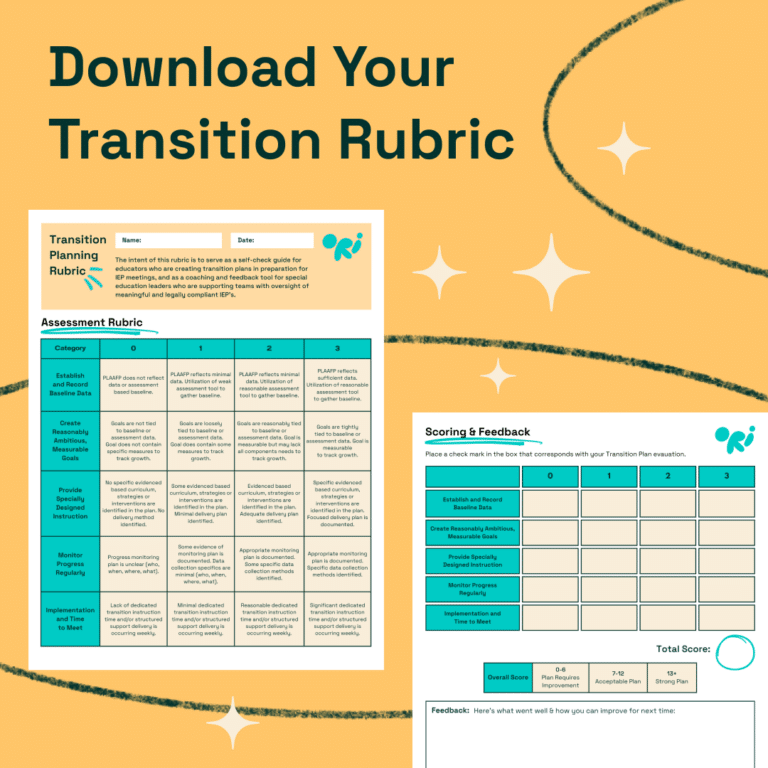


Self-advocacy is a critical skill for students with special needs. It empowers them to understand their strengths, recognize their weaknesses, and express their needs effectively. This comprehensive guide will assist you in setting effective self-advocacy IEP goals for your students.
Self-advocacy is the ability to understand and communicate one’s needs. It involves recognizing one’s rights, responsibilities, and personal boundaries. It’s a crucial skill for students with special needs as it enables them to navigate their learning environment more effectively.
Incorporating self-advocacy goals into a student’s Individualized Education Program (IEP) is vital. It empowers students to take an active role in their education, fostering independence and self-confidence. It also helps them to communicate their needs effectively to teachers, peers, and family members.
Our Transition Planning Rubric is designed to support district leaders and educators in guiding their teams towards excellence in transition planning.
It provides comprehensive criteria that cover the breadth of transition planning, from gauging student engagement to evaluating post-secondary goals and services.
Expand your team’s capabilities and improve the success of IEP meetings.

When setting self-advocacy IEP goals, it’s crucial to ensure they are SMART: Specific, Measurable, Achievable, Relevant, and Time-bound. Each of these characteristics plays a vital role in the effectiveness of the IEP goals.
Specific: Goals should be clear and well-defined, leaving no room for misunderstanding. A specific goal outlines what the student should achieve, under what conditions, and often includes a criterion for acceptable performance. This specificity helps students understand exactly what is expected of them, and it allows educators to accurately measure progress.
Measurable: A goal must have criteria that allow for tracking progress and determining when the goal has been met. This could be a numerical range, a percentage, or any other quantifiable measure. Measurable goals help keep students motivated and allow educators to adjust instruction based on the student’s progress.
Achievable: Goals should be realistic given the student’s abilities and the resources available. They should stretch the student, but still be within reach. Achievable goals help to increase student motivation and self-efficacy.
Relevant: The goals should be directly related to what the student needs to achieve academically, socially, or behaviorally. They should align with the student’s educational needs and their long-term objectives. Relevant goals ensure that the student’s time and effort are being directed toward meaningful outcomes.
Time-bound: Goals should have a clear timeframe by which they will be achieved. This could be by a certain date or within a certain educational term. Time-bound goals provide a sense of urgency and help in planning and pacing instruction.
IEP compliance factors are also crucial in setting SMART self-advocacy goals. These factors ensure that the goals align with the student’s individual needs and the legal requirements of the IEP process. They include present levels of academic achievement and functional performance (PLAAFP), measurable annual goals, and a description of how progress will be measured.
Creating SMART self-advocacy IEP goals is a critical step in empowering students with special needs. It helps them understand and communicate their needs effectively, fostering independence and self-confidence. By setting SMART goals and incorporating IEP compliance factors, educators can provide students with the tools they need to succeed.
Learn how to help students with special needs to become more independent and successful in their academic and daily lives.

Self-awareness
By (date), when participating in their IEP meeting, the student will actively contribute to the creation of their own goals, including self-advocacy IEP goals, by providing input and expressing their preferences and needs, improving from 0/10 opportunities to 8/10 opportunities.
By (date), when asked to describe their specific disability and its impact on their academic and social life, the student will accurately do so within 5 minutes, improving from 0/10 opportunities to 8/10 opportunities.
By (date), when asked to demonstrate a self-advocacy strategy from their toolbox, the student will do so within 5 minutes, improving from 0/10 opportunities to 8/10 opportunities.
By (date), when asked to complete a self-reflective journal entry documenting their academic and personal progress, the student will do so within 30 minutes, improving from 0/10 opportunities to 8/10 opportunities.
Communication
By (date), when given a writing task, the student will produce clear, coherent work free from major grammatical errors within the assigned deadline, improving from 0/10 opportunities to 8/10 opportunities.
By (date), when asked to participate in class discussions or present information, the student will do so clearly and effectively within 5 minutes, improving from 0/10 opportunities to 8/10 opportunities.
By (date), when in a social situation, the student will use appropriate body language, facial expressions, and gestures within 5 minutes, improving from 0/10 opportunities to 8/10 opportunities.
Decision-making
By (date), when faced with a decision in an academic, social, or daily living situation, the student will make a thoughtful and well-reasoned choice within 10 minutes, improving from 0/10 opportunities to 8/10 opportunities.
By (date), when asked to identify their abilities, preferences, and areas for growth, the student will do so accurately within 10 minutes, improving from 0/10 opportunities to 8/10 opportunities.
By (date), when faced with a problem, the student will employ a systematic approach, generate multiple solutions, evaluate outcomes, and adapt strategies accordingly within 15 minutes, improving from 0/10 opportunities to 8/10 opportunities.
Rights and responsibilities
By (date), when asked to articulate their accommodation needs or engage in conversations with teachers and service providers, the student will do so within 5 minutes, improving from 0/10 opportunities to 8/10 opportunities.
By (date), when asked to articulate their rights and responsibilities as a student with an IEP, the student will do so accurately within 10 minutes, improving from 0/10 opportunities to 8/10 opportunities.
By (date), when asked to participate in the development and review of their IEP goals, the student will do so actively within the allotted meeting time, improving from 0/10 opportunities to 8/10 opportunities.
Goal-setting
By (date), when given a task or assignment, the student will use organizational tools, create and follow a schedule, and effectively manage their time to meet deadlines, improving from 0/10 opportunities to 8/10 opportunities.
By (date), when given a long-term assignment or project, the student will break down the task into manageable parts, create a timeline for completion, and adhere to this timeline for at least 4 out of 5 assignments, improving goal-setting skills from 0/5 assignments to 4/5 assignments.
By (date), the student will identify at least three personal academic goals for the semester, create a plan of action for each goal, and demonstrate progress towards achieving these goals in bi-weekly check-ins with their teacher, improving goal-setting skills from 0/3 goals to 3/3 goals.
Prepare your students for lifelong success with Ori’s Transition Curriculum.
Teaching self-advocacy skills involves a combination of direct instruction, role-playing, and real-world practice. Here are some strategies:
Incorporating self-advocacy IEP goals into a student’s IEP is a powerful way to empower them to take an active role in their education. By setting SMART goals and using effective teaching strategies, we can equip our students with the skills they need to succeed.
With Ori Learning’s transition curriculum, your school or district can enjoy the peace of mind of having access to an easy-to-implement, comprehensive program that allows you to report on progress and demonstrate compliance. Find out how our curriculum can help you meet IEP goals safely and consistently by booking a call with one of our representatives today.
Self-advocacy in IEP refers to the ability of students with special needs to understand and communicate their own needs, helping them navigate their learning environment effectively.
Teaching self-advocacy skills can involve explicit instruction on rights and responsibilities, role-playing to practice skills, and providing real-world practice opportunities.
Progress is measured using criteria like frequency of participation, accuracy in describing disabilities, and effectiveness in demonstrating strategies, often tracked through improvements over time.